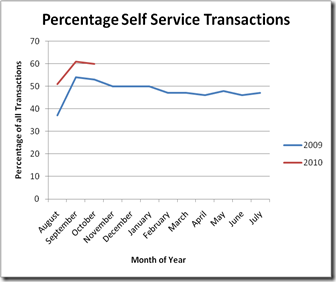Information and Action
The real test of the usefulness of Management Information is the action you can take on the basis of it, or what learning you take from it that in turn may lead to action. A customer (Queen’s University Belfast) recently ran a student survey at one of their libraries and on the basis of this re-located some self-service terminals. This was the impact of the change on self-service terminal usage (note that figures for July 2009 are interpolated).
Surveys are a form of Management information, and this one didn’t just produce “Fancy that” information. It produced results that could be (and in this case, were) put into action. The subsequent monitoring of results closed the loop. If (in the absence of any other change) transactions had fallen rather than climbed, the terminals could have been moved again either to somewhere else or even back to their previous locations.
This was an example of good practice, but there are far too many examples of wasted effort in the Management Information world. Information is expensive to collect, collate, present and (an often overlooked point), expensive to absorb. You can waste end-users time (and therefore by implication, the institution’s money) by sending them heaps of data that they can neither learn from, nor take action on. Furthermore, a mass of information presented in different reports at different intervals can hide the important stuff as surely as a forest can hide a leaf or a blizzard a snowflake. Before you specify a report or decide on a data-collection exercise, it is always worth pondering what actions are available to you when you get the output.



Recent Comments